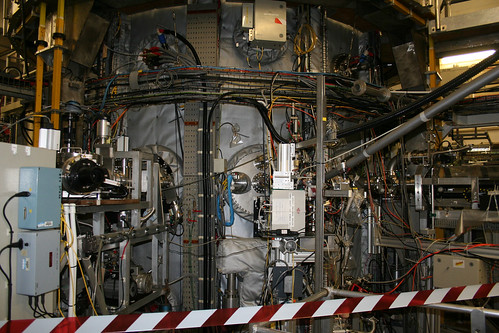Did you know that the world’s largest nuclear fusion reactor is not far from London – just outside Oxford in fact (map link).
Before you worry that the dreaming spires will melt in a nuclear accident, Fusion is the sort-of nice side to nuclear power, the version that doesn’t go bang and could potentially be the fuel of the future.
While a huge fusion reactor is being built in France to prove the technology, it is the UK that leads the development work – and their research labs are open for public tours. You can get right up close and personal with a fusion reactor.
You have to book yonks in advance, but they are free, and you are allowed to take photos – it is not the sort of secret secure place that a fission reactor has to be.
The Culham research labs have just announced the following dates for tours in 2013:
- 10 July
- 11 September
- 16 October
- 27 November
They also have a reserve list in case of cancellations for the following dates:
- 13 February
- 13 March
- 17 April
- 15 May
- 12 June
The free events start at 6.45pm and last for approximately 2.5 hours. To reserve places, call 01235 466375 or email lisa.jones@ccfe.ac.uk. Trains run to Culham from London, via Oxford or Didcot.
I visited a few years ago – my blog post about that is here.








I had no idea these things actually existed yet, I thought they were way off!
They are way off if what you want is more energy out than you put in to keep the reaction going. In the 1950s Harwell ran a project called Zeta which was supposed to lead the way to cheap fusion power — you know, when electricity is ‘too cheap to meter’.
The fusion reaction worked. Trouble was, Zeta needed so much energy to keep the reaction going that it was a net consumer of power. Six decades later scientists are still working on it. They’ll get there in the end, no doubt.
They’re not way off as you put it – one of the test reactors can now generate more output than input. However, at the moment, only in small bursts, and that it what the French plant is designed to prove – can it be done on a commercial basis.
People have been taking about fusion as the next big thing for at least 60 years. It would be fantastic if fusion reactors can be made to work commercially – perhaps one day – but in the meantime, researchers have learned an awful lot of interesting plasma physics!
A fusion reactor would not be entirely “clean” – they still produce a fair amount of radioactive waste materials (particularly the structure), but much better than fission reactors, and true they don’t go bang.
Which test reactor can produce more energy than it takes to operate? Perhaps I am wrong, but I thought JET was the most successful, and they still talk about the one time in 1997 when they produced an output of 16MW from an input of 24MW (Q=0.65). A Japanese deuterium-deuterium reactor achieve a result which would have had a Q=1.25 *if* it had operated deuterium-tritium instead, but it is not capable of using tritium.
Incidentally, ITER will not be operational until 2020, and won’t be generating energy before about 2030. If it works, we may see commercial reactors by about 2040 or 2050.
A bit closer to home, when guiding friends into the Olympics via the Victoria Gate I’d point out where the Queen Mary College nuclear fission reactors used to be, about 50m south, and about 30 years in the past, of the concession stands of the stadium. http://www.hse.gov.uk/foi/releases/queenmary230906.htm . A 10W and a 100KW reactor. I wonder if anyone’s currently splitting the atom in London today.
Gosh, a nuclear reactor in London! Were (and are) there others? If I recall correctly, Fermi’s first pile was in a squash court in the middle of Chicago!
[fx:google]
OK, so there was also the Royal Navy’s JASON research reactor at Greenwich until 1996(!) – http://en.wikipedia.org/wiki/JASON_reactor – and the QM reactor, on the Mile End Road site from 1962 and then up the road at Marshgate Lane from 1967 to 1982. Here is a picture: http://www.library.qmul.ac.uk/node/1563